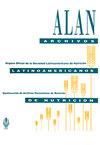阿根廷拉普拉塔城市周边学童身体成分与营养状况和社会环境条件的关系
IF 0.3
4区 医学
Q4 NUTRITION & DIETETICS
引用次数: 0
摘要
摘要:阿根廷拉普拉塔城市周边学童的身体成分与营养状况和社会环境条件的关系。本研究的目的是评估阿根廷拉普拉塔城市周边学童的身体成分与营养状况和居住社会环境条件的关系。对2014-2017年3284名4-12岁学龄儿童的体重、身高、臂围、肱三头肌和肩胛下皮褶进行了测量。参照国家健康和营养检查调查(NHANES) III评估营养状况,确定以下类别:正常、体重不足、发育迟缓、消瘦、超重和肥胖。以上臂肌肉面积(UMA)和上臂脂肪面积(UFA)评价体成分。还计算了UMA和UFA的赤字和超额。中心脂肪分布由肩胛下-肱三头指数确定。使用结构化问卷调查社会环境特征。采用卡方检验对营养状况和体成分指标的患病率进行性别比较。使用分类主成分分析分析社会环境数据,区分出更有利和不利的条件。营养状况结果:正常,64.5%;发育不良,3.4%;体重过轻,0.0%;浪费,0.1%;超重占15.6%肥胖占16.4%儿童的营养状况随着其家庭的社会环境状况变得更加不稳定而恶化。长期的社会环境压力表现为正常、发育不良、超重和肥胖儿童肌肉组织减少。目前的结果证明了贫困对儿童生长发育的强烈影响,同时也强调了对隐性营养不良儿童进行持续监测的必要性。Arch latin nur 2020;70(2): 81 - 94。本文章由计算机程序翻译,如有差异,请以英文原文为准。
Body composition in relation to nutritional status and socio-environmental conditions in schoolchildren living in the urban periphery of La Plata, Argentina
Summary: Body composition in relation to nutritional status and socio-environmental conditions in schoolchildren living in the urban periphery of La Plata, Argentina. The aim of this study was to evaluate body composition in relation to nutritional status and socio-environmental conditions of residence in schoolchildren living in the urban periphery of La Plata, Argentina. Weight, height, arm circumference and tricipital and subscapular skinfolds were measured in 3,284 schoolchildren aged 4-12 years in the period 2014-2017. The National Health and Nutrition Examination Survey (NHANES) III reference was used to assess nutritional status, identifying the following categories: normal, underweight, stunting, wasting, overweight and obesity. Body composition was evaluated based on upper arm muscle area (UMA) and upper arm fat area (UFA). Deficit and excess UMA and UFA were also calculated. Central fat distribution was determined with the subscapular-tricipital index. Socio-environmental characteristics were surveyed using a structured questionnaire. The prevalence of nutritional status and body composition indicators were compared by sex using Chi square test. Socio-environmental data were analyzed using categorical Principal Component Analysis, discriminating into more favorable and unfavorable conditions. Nutritional status results were as follows: normal, 64.5%; stunting, 3.4%; underweight, 0.0%; wasting, 0.1%; overweight, 15.6% and obesity 16.4%. The nutritional status of children worsened as the socio-environmental condition of their families became more precarious. Long-term socio-environmental stress manifested as decreased muscle tissue in normal, stunted, overweight and obese children. The current results evidence the strong impact of poverty on child growth and development and at the same time enforce the need for continuous monitoring of children with hidden malnutrition. Arch Latinoam Nutr 2020; 70(2): 81-94.
求助全文
通过发布文献求助,成功后即可免费获取论文全文。
去求助
来源期刊
CiteScore
0.50
自引率
0.00%
发文量
31
期刊介绍:
Archivos Latinoamericanos de Nutrición (ALAN) is the official publication of the Sociedad Latinoamericana de Nutición (SLAN), for the dissemination of knowledge in the fields of food and nutrition, principally throughout the American Hemisphere. Articles in Spanish, English, Portuguese and French are accepted, both from the Society members and from nonmembers, in the following categories: 1. General articles (critical scientific reviews); 2. Research articles (originals); 3. Papers in applied nutrition (analytical results from intervention programs and discussion of reconmendations of practical application), and 4. Letters to Editor (short comments of general interest or about scientific facts and results previously published in Archives).

 求助内容:
求助内容: 应助结果提醒方式:
应助结果提醒方式:


